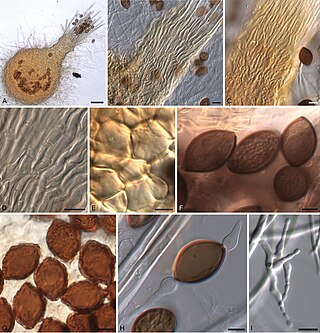Related Research Articles

Sordariomycetes is a class of fungi in the subdivision Pezizomycotina (Ascomycota). It is the second-largest class of Ascomycota, with a worldwide distribution that mostly accommodates terrestrial based taxa, although several can also be found in aquatic habitats. Some are phytopathogens that can cause leaf, stem, and root diseases in a wide variety of hosts, while other genera can cause diseases in arthropods and mammals.

The Hypocreales are an order of fungi within the class Sordariomycetes. In 2008, it was estimated that it contained some 237 genera, and 2647 species in seven families. Since then, a considerable number of further taxa have been identified, including an additional family, the Stachybotryaceae. Wijayawardene et al. in 2020 added more families and genera to the order. According to the Catalog of Life, As of April 2021 the Hypocreales contains 6 families, 137 genera, and 1411 species. Hyde et al. (2020a) listed 14 families under Hypocreales, while, Wijayawardene et al. (2022) accepted 15 families in the order, where Cylindriaceae was additionally added. Earlier, Hyde et al. (2020a) had placed Cylindriaceae in class Xylariomycetidae. Samarakoon et al. (2022) agreed. Hence, Cylindriaceae should have been excluded from Hypocreales and placed in Xylariomycetidae. Xiao et al. (2022) recently introduced a new family Polycephalomycetaceae to Hypocreales.

The Pleosporales is the largest order in the fungal class Dothideomycetes. By a 2008 estimate, it contained 23 families, 332 genera and more than 4700 species. The majority of species are saprobes on decaying plant material in fresh water, marine, or terrestrial environments, but several species are also associated with living plants as parasites, epiphytes or endophytes. The best studied species cause plant diseases on important agricultural crops e.g. Cochliobolus heterostrophus, causing southern corn leaf blight on maize, Phaeosphaeria nodorum causing glume blotch on wheat and Leptosphaeria maculans causing a stem canker on cabbage crops (Brassica). Some species of Pleosporales occur on animal dung and a small number occur as lichens and rock-inhabiting fungi.

Hypocreomycetidae is a subclass of sac fungi.
The Koralionastetaceae are a family of fungi in the Ascomycota phylum. This family was taxonomically classified into class of Sordariomycetes and order of Koralionastetales and subclass Lulworthiomycetidae.

The Annulatascaceae are a family of fungi in the monotypic order Annulatascales of the class Sordariomycetes of the Ascomycota. The family had not been assigned to any order, until 2020 when it was placed with a new order Annulatascales M.J. D'souza, Maharachch. & K.D. Hyde.
The Papulosaceae are a family of fungi in the class Sordariomycetes and in the subclass Diaporthomycetidae. The family has not been assigned to any order. A monotypic taxon, the Papulosaceae contained the single genus Papulosa, which in turn contains the single species Papulosa amerospora. This species, found in the eastern USA, grows in Juncus stems.
The Lulworthiaceae are a family of marine fungi in the Ascomycota, class Sordariomycetes. Species in the family have a widespread distribution in both temperate and tropical oceans, and are typically found growing on submerged wood or on seaweed. In 2000, Molecular analysis of several species of Lulworthia and Lindra led to the reassignment of their parent genera to the new order Lulworthiales in addition to the new family Lulworthiaceae. In 2020, a large fungi study added more genera to the family.

Melanospora is a genus of fungi within the Ceratostomataceae family.

Bertia is a genus of fungi within the Bertiaceae family, and Hypocreomycetidae subclass.

Glomerellaceae is a monotypic family of fungi in the class Sordariomycetes that contains only one genus, Colletotrichum.
Lulworthiomycetidae is a subclass of Sordariomycetes.
Lichenoverruculina is a fungal genus in the family Hyponectriaceae and order Amphisphaeriales. This is a monotypic genus, containing the single species Lichenoverruculina sigmatospora. which was published in Herzogia vol.24 (2) on page 274 in 2011.
Savoryellomycetidae is a subclass of sac fungi within the class of Sordariomycetes. It contains 4 known orders of Conioscyphales, Fuscosporellales, Pleurotheciales and Savoryellales.
Fuscosporellales is an order of fungi within the phylum of Ascomycota and in the class Sordariomycetes and subdivision of Pezizomycotina.
Savoryellaceae is a family of aquatic based fungi. It is the only family in the monotypic order Savoryellales within the class Sordariomycetes, division Ascomycota.
Savoryella is a genus of freshwater and marine based fungi in the family Savoryellaceae and the order Savoryellales.
Pisorisporiales is an order of fungi within the phylum of Ascomycota and in the class Sordariomycetes and subdivision of Pezizomycotina and also its own subclass Pisorisporiomycetidae.
Pleurotheciaceae is a family of ascomycetous fungi within the monotypic order of Pleurotheciales in the subclass Savoryellomycetidae and within the class Sordariomycetes.

The Torpedosporales are an order of marine based fungi in the class Sordariomycetes, subclass Hypocreomycetidae. Most are found on wood substrates in the water.
References
- ↑ Wijayawardene, Nalin; Hyde, Kevin; Al-Ani, Laith Khalil Tawfeeq; Somayeh, Dolatabadi; Stadler, Marc; Haelewaters, Danny; et al. (2020). "Outline of Fungi and fungus-like taxa". Mycosphere. 11: 1060–1456. doi: 10.5943/mycosphere/11/1/8 .
- ↑ Panno, L.; Bruno, M.; Voyron, S.; Anastasi, A.; Gnavi, G.; Miserere, L.; Varese, G.C. (2013). "Diversity, ecological role and potential biotechnological applications of marine fungi associated to the seagrass Posidonia oceanica". New Biotechnol. 30: 685–694.
- ↑ Raghukumar, S. (2017). "Fungi in Coastal and Oceanic Marine Ecosystems". Marine Fungi. Cham, Switzerland: download.
- ↑ Kohlmeyer, J.; Spatafora, J.W.; Volkmann-Kohlmeyer, B. (2000). "Lulworthiales, a new order of marine Ascomycota". Mycologia. 92: 453–458.
- ↑ Campbell, J.; Inderbitzin, P.; Kohlmeyer, J.; Volkmann-Kohlmeyer, B. (2009). "Koralionastetales, a new order of marine Ascomycota in the Sordariomycetes". Mycol. Res. 113: 373–380.